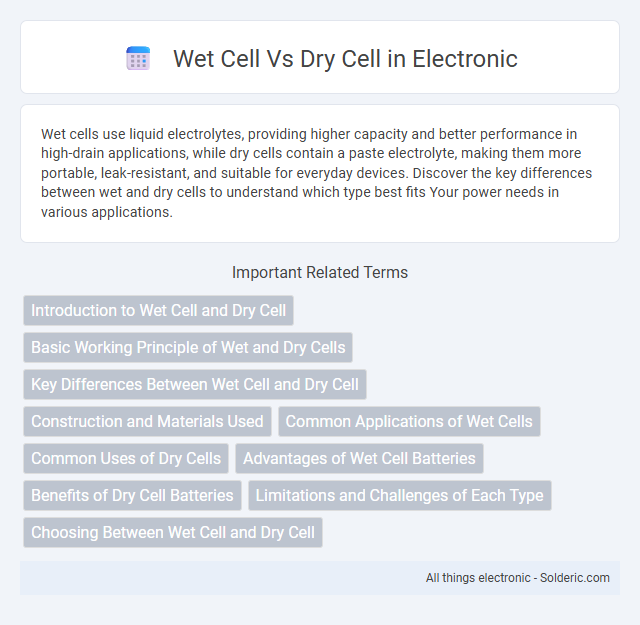Wet cells use liquid electrolytes, providing higher capacity and better performance in high-drain applications, while dry cells contain a paste electrolyte, making them more portable, leak-resistant, and suitable for everyday devices. Discover the key differences between wet and dry cells to understand which type best fits Your power needs in various applications.
Comparison Table
| Feature | Wet Cell | Dry Cell |
|---|---|---|
| Electrolyte | Liquid or paste electrolyte | Gel or paste electrolyte |
| Mobility | Bulkier, less portable | Compact, portable |
| Leakage Risk | Higher, due to liquid electrolyte | Lower, safer due to paste form |
| Maintenance | Requires regular maintenance | Maintenance-free or minimal |
| Applications | Automobile batteries, large-scale power backup | Flashlights, remote controls, small electronics |
| Voltage Output | Typically 2V per cell | Typically 1.5V per cell |
| Durability | Shorter lifespan, sensitive to orientation | Longer lifespan, can operate in any position |
Introduction to Wet Cell and Dry Cell
Wet cells use a liquid electrolyte, typically sulfuric acid or potassium hydroxide, to facilitate chemical reactions that generate electrical energy, making them common in automotive batteries. Dry cells contain a paste electrolyte, which is more stable and leak-resistant, often found in household batteries like AA or AAA. Understanding the differences in electrolyte types helps you choose the appropriate battery for your device's performance and maintenance needs.
Basic Working Principle of Wet and Dry Cells
Wet cells operate using a liquid electrolyte that facilitates the chemical reaction between electrodes, generating electrical energy through ion movement in the fluid medium. Dry cells employ a paste or solid electrolyte to enable ion flow between the anode and cathode, providing a compact and leak-resistant power source. Both types rely on electrochemical reactions but differ primarily in the physical state of their electrolytes, affecting their applications and portability.
Key Differences Between Wet Cell and Dry Cell
Wet cells contain a liquid electrolyte, typically sulfuric acid or potassium hydroxide, while dry cells use a paste or solid electrolyte, making them more portable and less prone to leakage. Wet cells are commonly used in automotive batteries due to their high current output and rechargeability, whereas dry cells are ideal for small electronic devices because of their compact size and convenience. Your choice depends on the application's power requirements, durability, and mobility needs.
Construction and Materials Used
Wet cells contain liquid electrolytes, typically sulfuric acid or potassium hydroxide, housed in a sturdy, often glass or plastic container, with electrodes made of lead or zinc. Dry cells use a paste electrolyte, commonly ammonium chloride or zinc chloride, enclosed in a sealed metal can, featuring a zinc anode and a carbon rod cathode. Your choice between wet and dry cells depends on the application, with wet cells offering higher capacity and dry cells providing portability and leak resistance.
Common Applications of Wet Cells
Wet cells are commonly used in automotive batteries, uninterruptible power supplies (UPS), and industrial applications due to their high energy capacity and ability to deliver large currents. These batteries are preferred in heavy-duty equipment, marine applications, and backup power systems where durability and sustained power output are critical. Wet cells typically contain a liquid electrolyte, which allows for efficient ion transfer and robust performance under demanding conditions.
Common Uses of Dry Cells
Dry cells are commonly used in portable electronic devices such as remote controls, flashlights, and cameras due to their compact size and leak-resistant design. They power everyday household gadgets including clocks, toys, and wireless computer peripherals. Their convenience and reliability make dry cells ideal for applications requiring lightweight and maintenance-free energy sources.
Advantages of Wet Cell Batteries
Wet cell batteries offer higher surge current capacity, making them ideal for automotive starters and heavy-duty applications. Their design allows for easier electrolyte replenishment and maintenance, extending battery life compared to sealed dry cells. Wet cells typically provide better performance in extreme temperatures, enhancing reliability in diverse environmental conditions.
Benefits of Dry Cell Batteries
Dry cell batteries offer a compact, lightweight design ideal for portable devices and smartphones, providing enhanced convenience for Your everyday use. Their sealed construction prevents leakage and corrosion, ensuring longer shelf life and improved safety compared to wet cell batteries. With better resistance to temperature variations and reduced maintenance requirements, dry cell batteries deliver reliable performance in a wide range of applications.
Limitations and Challenges of Each Type
Wet cells face limitations such as leakage risks, maintenance requirements due to liquid electrolyte evaporation, and sensitivity to orientation, which can cause spillage or short circuits. Dry cells, while more portable and maintenance-free, often suffer from shorter shelf life, lower capacity under heavy load, and potential voltage drops during prolonged use. Both types present challenges in balancing energy density, safety, and environmental impact, influencing their suitability for specific applications.
Choosing Between Wet Cell and Dry Cell
Choosing between a wet cell and a dry cell depends on your specific energy needs and application. Wet cells, typically used in automotive batteries, offer high current output and are rechargeable, ideal for starting engines and heavy-duty tasks. Dry cells provide portability, leak resistance, and convenience, making them suitable for everyday devices like remote controls and flashlights.
Wet cell vs Dry cell Infographic

 solderic.com
solderic.com